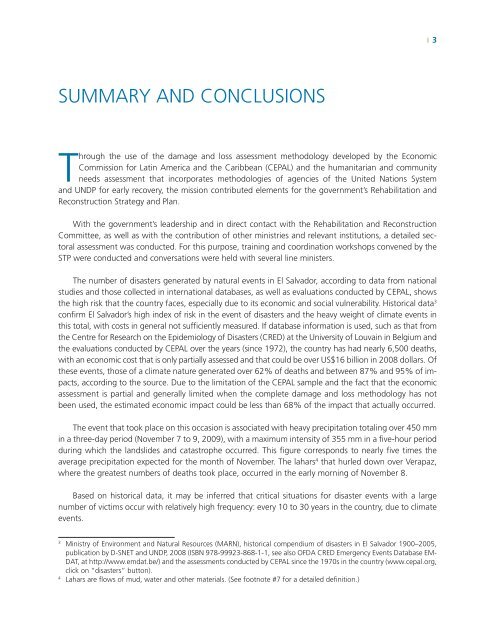El Salvador - GFDRR
El Salvador - GFDRR
El Salvador - GFDRR
Create successful ePaper yourself
Turn your PDF publications into a flip-book with our unique Google optimized e-Paper software.
| 3<br />
SUMMARY AND CONCLUSIONS<br />
Through the use of the damage and loss assessment methodology developed by the Economic<br />
Commission for Latin America and the Caribbean (CEPAL) and the humanitarian and community<br />
needs assessment that incorporates methodologies of agencies of the United Nations System<br />
and UNDP for early recovery, the mission contributed elements for the government’s Rehabilitation and<br />
Reconstruction Strategy and Plan.<br />
With the government’s leadership and in direct contact with the Rehabilitation and Reconstruction<br />
Committee, as well as with the contribution of other ministries and relevant institutions, a detailed sectoral<br />
assessment was conducted. For this purpose, training and coordination workshops convened by the<br />
STP were conducted and conversations were held with several line ministers.<br />
The number of disasters generated by natural events in <strong>El</strong> <strong>Salvador</strong>, according to data from national<br />
studies and those collected in international databases, as well as evaluations conducted by CEPAL, shows<br />
the high risk that the country faces, especially due to its economic and social vulnerability. Historical data 3<br />
confirm <strong>El</strong> <strong>Salvador</strong>’s high index of risk in the event of disasters and the heavy weight of climate events in<br />
this total, with costs in general not sufficiently measured. If database information is used, such as that from<br />
the Centre for Research on the Epidemiology of Disasters (CRED) at the University of Louvain in Belgium and<br />
the evaluations conducted by CEPAL over the years (since 1972), the country has had nearly 6,500 deaths,<br />
with an economic cost that is only partially assessed and that could be over US$16 billion in 2008 dollars. Of<br />
these events, those of a climate nature generated over 62% of deaths and between 87% and 95% of impacts,<br />
according to the source. Due to the limitation of the CEPAL sample and the fact that the economic<br />
assessment is partial and generally limited when the complete damage and loss methodology has not<br />
been used, the estimated economic impact could be less than 68% of the impact that actually occurred.<br />
The event that took place on this occasion is associated with heavy precipitation totaling over 450 mm<br />
in a three-day period (November 7 to 9, 2009), with a maximum intensity of 355 mm in a five-hour period<br />
during which the landslides and catastrophe occurred. This figure corresponds to nearly five times the<br />
average precipitation expected for the month of November. The lahars 4 that hurled down over Verapaz,<br />
where the greatest numbers of deaths took place, occurred in the early morning of November 8.<br />
Based on historical data, it may be inferred that critical situations for disaster events with a large<br />
number of victims occur with relatively high frequency: every 10 to 30 years in the country, due to climate<br />
events.<br />
3<br />
Ministry of Environment and Natural Resources (MARN), historical compendium of disasters in <strong>El</strong> <strong>Salvador</strong> 1900–2005,<br />
publication by D-SNET and UNDP, 2008 (ISBN 978-99923-868-1-1, see also OFDA CRED Emergency Events Database EM-<br />
DAT, at http://www.emdat.be/) and the assessments conducted by CEPAL since the 1970s in the country (www.cepal.org,<br />
click on “disasters” button).<br />
4<br />
Lahars are flows of mud, water and other materials. (See footnote #7 for a detailed definition.)
















